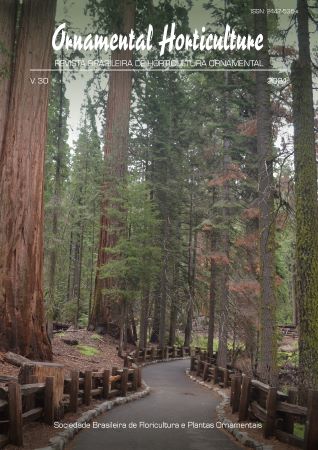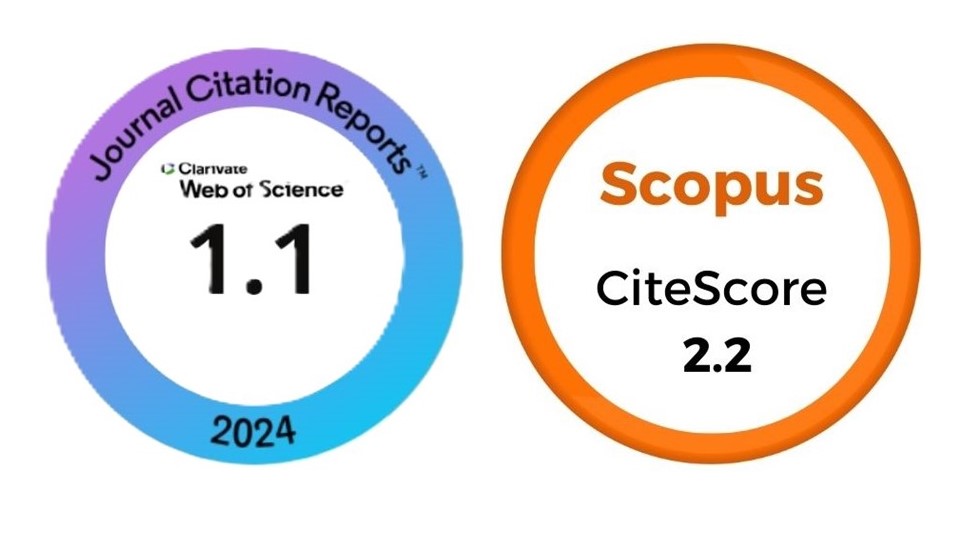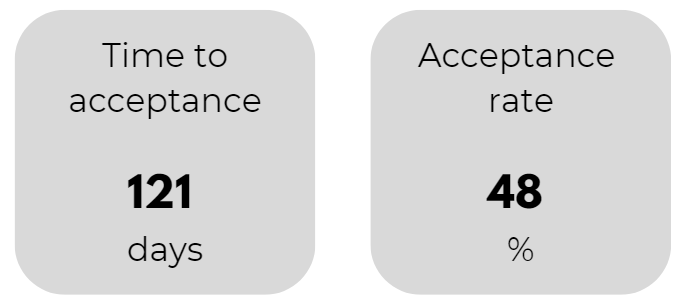Aplicação de ácido húmico via solo atenua os impactos adversos da alcalinidade na rosa
DOI:
https://doi.org/10.1590/2447-536X.v30.e242710%20Palavras-chave:
enzima antioxidante, extravasamento de eletrólitos, malondialdeído, prolina, proteína, teor de açúcarResumo
O estresse alcalino é um importante fator ambiental que limita o crescimento e a produtividade das roseiras. O ácido húmico (AH) é uma substância natural que demonstrou ter vários efeitos benéficos no crescimento das plantas e na tolerância ao estresse. As rosas (Rosa hybrida L.) estão entre as flores de corte mais importantes e populares do mundo, dominando o mercado de exportação de flores de corte. Este estudo investigou os efeitos da aplicação de AH nas propriedades fisiológicas e bioquímicas de roseiras cultivadas em condições alcalinas. Foi utilizado delineamento inteiramente casualizado com três repetições. Cada repetição consistiu de dois vasos contendo uma única planta de rosa. O ácido húmico foi aplicado nas doses de 0, 500, 1.000 e 2.000 mg L-1 via solo em intervalos de 15 dias durante dois meses. Plantas tratadas com 1.000 mg L-1 de HA exibiram níveis significativamente mais elevados de proteína total, prolina, atividade de catalase, atividade de guaiacol peroxidase e capacidade antioxidante. As plantas controle (que não receberam AH) apresentaram os maiores níveis de malondialdeído e vazamento de eletrólitos, indicando maior dano celular. Plantas tratadas com 500 mg L-1 de HA apresentaram maior teor de açúcar e atividade de ascorbato peroxidase. No geral, os resultados deste estudo sugerem que a aplicação de AH pode ser uma estratégia eficaz para melhorar a tolerância das roseiras ao stress alcalino e aumentar o seu crescimento e produtividade em solos alcalinos.
Downloads
Referências
AEBI, H. Catalase in vitro. Methods in Enzymology, v.105, p.121-126, 1984. https://doi.org/10.1016/s0076-6879(84)05016-3
AMPONG, K.; THILAKARANTHNA, M.S.; GORIM, L.Y. Understanding the role of humic acids on crop performance and soil health. Frontiers in Agronomy, v.4, p.848621, 2022. https://doi.org/10.3389/fagro.2022.848621
ATHAR, H-U-R.; ZULFIQAR, F.; MOOSA, A.; ASHRAF, M.; ZAFAR, Z.U.; ZHANG, L.; AHMED, N.; KALAJI, H.M.; NAFEES, M.; HOSSAIN, M.A.; ISLAM, M.S.; EL SABAGH, A. SIDDIQUE K.H.M. Salt stress proteins in plants: An overview. Frontiers in Plant Science, v.13, p.999058, 2022. https://doi.org/10.3389/fpls.2022.99905
BRADFORD, M.M.; A rapid and sensitive method for the quantitation of microgram quantities of protein utilizing the principle of protein-dye binding. Analytical Biochemistry, v.72, n.1-2, p.248-254, 1976. https://doi.org/10.1006/abio.1976.9999
GHASEMI, Z.; JAHANBIN, S.; LATIFMANESH, H. Effects of humic acid foliar application on millet (Panicum miliaceum L.) yield and some of the biochemical and physiological parameters under drought stress condition in Ramjerd region of Fars. Environmental Stresses in Crop Sciences, v.15, n.1, p.137-147, 2022. https://doi.org/10.22077/escs.2020.3666.1890
CAVALCANTI FILHO P.F.M.; BAIA, D.C.; RIBEIRO, R.C.; ROSA, R.C.C.; CANELLAS, L.P. Humic acids induce the expression of nitrate transporters in passion-fruit seedlings. Soils and Plant Nutrition, v.45, e–941, 2023. https://doi.org/10.1590/0100-29452023941
CHEN, Q.; QU, Z.; MA, G.; WANG, W.; DAI, J.; ZHANG, M.; WEI, Z.; LIU, Z. Humic acid modulates growth, photosynthesis, hormone and osmolytes system of maize under drought conditions. Agricultural Water Management. v.263, p.107447, 2022. https://doi.org/10.1016/j.agwat.2021.107447
DOLE, J.M.; WILKINS, H.F. 2005. Floriculture: Principles and Species. New Jersey: Prentice Hall, 2005.1023p.
ESPIN, J.C.; SOLER-RIVAS, C.; WICHERS, H.J. Characterization of the total free radical scavenger capacity of vegetable oils and oil fractions using 2,2-diphenyl-2-picrylhydrazyl radical. Journal of Agricultural and Food Chemistry, v.48, p.648-656, 2000. https://doi.org/10.1021/jf9908188
HASANUZZAMAN, M.; BHUYAN, M.; ZULFIQAR, F.; RAZA, A.; MOHSIN, S.M.; MAHMUD, J.A.; FUJITA, M.; FOTOPOULOS, V. Reactive oxygen species and antioxidant defense in plants under abiotic stress: Revisiting the crucial role of a universal defense regulator. Antioxidants, v.9, p.681, 2020. https://doi.org/10.3390/antiox9080681
HNILICKOVA, H.; KRAUS, K.; VACHOVA, P.; HNILICKA, F. Salinity stress affects photosynthesis, malondialdehyde formation, and proline content in Portulaca oleracea L. Plants, v.10, p.845, 2021. https://doi.org/10.3390/plants10050845
HORST, J.H.; CAKMAK, I. Effects of aluminum on lipid peroxidation, superoxide dismutase, catalase, and peroxidase activities in root tips of soybean (Glycin max). Physiologia Plantarum, v.83, p.463-468, 1991. https://doi.org/10.1111/j.1399-3054.1991.tb00121.x
IRIGOYEN, J.J.; EMERICH, D.W.; SANCHEZ-DIAZ, M. Water stress induced changes in concentrations of proline and total soluble sugars in nodulated alfalfa (Medicago sativa) plants. Physiologia Plantarum, v.84, p.55-60, 1992. https://doi.org/10.1111/j.1399-3054.1992.tb08764.x
KANG, H.M.; SALTVEIT, M.E. Chilling tolerance of maize, cucumber and rice Seedling (leaves and roots) and differentially affected by salicylic acid. Physiologia Plantarum, v.115, p.571-576, 2002. https://doi.org/10.1034/j.1399-3054.2002.1150411.x
LASHEEN, F.F.; HEWIDY, M.; ABDELHAMID, A.N.; THABET, R.S.; ABASS, M.M.M.; FAHMY, A.A.; SAUDY, H.S.; HASSAN, K.M. Exogenous application of humic acid mitigates salinity stress on Pittosporum (Pittosporum tobira) plant by adjusting the osmolytes and nutrient homeostasis. Journal of Crop Health, v.76, p.317-325, 2024. https://doi.org/10.1007/s10343-023-00939-9
LUTTS, S.; KINET, J. M.; BOUHARMONT, J. Changes in plant response to NaCl during development of rice (Oryza sativa L.) varieties differing in salinity resistance. Journal of Experimental Botany, v.46, n.12, p.1843-1852, 1995. https://doi.org/10.1093/jxb/46.12.1843
MISHRA, N.; JIANG, C.; CHEN, L.; PAUL, A.; CHATTERJEE, A.; SHEN, G. Achieving abiotic stress tolerance in plants through antioxidative defense mechanisms. Frontiers in Plant Science, v.14, p.1110622, 2023. https://doi.org/10.3389/fpls.2023.1110622
MSIMBIRA, L.A.; SMITH, D.L. The roles of plant growth promoting microbes in enhancing plant tolerance to acidity and alkalinity stresses. Frontiers in Sustainable Food Systems, v.4, p.106, 2020. https://doi.org/10.3389/fsufs.2020.00106
NAKANO, Y.; ASADA, K. Hydrogen peroxide is scavenged by ascorbate specific peroxidase in spinach chloroplasts. Plant and Cell Physiology, v.22, p.867-880, 1981. https://doi.org/10.1093/oxfordjournals.pcp.a076232
OLOGUNDUDU, F. Antioxidant enzymes and non-enzymatic antioxidants as defense mechanism of salinity stress in cowpea (Vigna unguiculata L. Walp) - Ife brown and Ife bpc. Bulletin of the National Research Centre, v.45, p.152, 2021. https://doi.org/10.1186/s42269-021-00615-w
RAJPUT, V.D.; HARISH SINGH, R.K.; VERMA, K.K.; SHARMA, L.; QUIROZ-FIGUEROA, F.R.; MEENA, M.; GOUR, V.S.; MINKINA, T.; SUSHKOVA, S.; MANDZHIEVA, S. Recent developments in enzymatic antioxidant defence mechanism in plants with special reference to abiotic stress. Biology (Basel), v.10, n.4, p.267, 2021. https://doi.org/10.3390/biology10040267
PAQUIN, R.; LECHASSEUR, P. Observationssur une methode de dosage de la praline libre dans les extraits de plantes. Canadian Journal of Botany, v.57, p.1851-1854, 1979. https://doi.org/10.1139/b79-233
RAI, K.K.; KAUSHIK, P. Free radicals mediated redox signaling in plant stress tolerance. Life, v.13, n.1, p.204, 2023. https://doi.org/10.3390/life13010204
SACHDEV, S.; ANSARI, S.A.; ANSARI, M.I.; FUJITA, M.; HASANUZZAMAN, M. Abiotic stress and reactive oxygen species: generation, signaling, and defense mechanisms. Antioxidants, v.10, p.277, 2021. https://doi.org/10.3390/antiox10020277
SHARMA, P.; LAKRA, N.; GOYAL, A.; AHLAWAT, Y.K.; ZAID, A.; SIDDIQUE, K.H.M. Drought and heat stress mediated activation of lipid signaling in plants: a critical review. Frontiers in Plant Science, v.14, p.1216835, 2023. https://doi.org/10.3389/fpls.2023.1216835
SHUKRY, W.M.; ABU-RIA, M.E.; ABO-HAMED, S.A.; ANIS, G.B.; IBRAHEEM, F. The efficiency of humic acid for improving salinity tolerance in salt sensitive rice (Oryza sativa): growth responses and physiological mechanisms. Gesunde Pflanzen, v.75, p.2639-2653, 2023. https://doi.org/10.1007/s10343-023-00885-6
UPDHYAYA, A.; SANKHLA, D.; DAVIS, T.D.; SANKHLA, N.; SMITH, B.N. Effect of paclobutrazol on the activities of some enzymes of activated oxygen metabolism and lipid peroxidation in sensing soybean leaves. Journal of Plant Physiology, v.121, p.453-467, 1985. https://doi.org/10.1016/S0176-1617(85)80081-X
VIKRAM, N.; SAGAR, A.; GANGWAR, C.; HUSAIN, R.; NARAYAN KEWAT, R. Properties of humic acid substances and their effect in soil quality and plant health. Humus and Humic Substances - Recent Advances. London: IntechOpen, 2022.
YANG, F.; YUANG, Y.; LIU, Q.; ZHANG, X.; GAI, SH.; JIN, Y.; CHENG, K. Artificial humic acid promotes growth of maize seedling under alkali conditions. Environmental Pollution, v.327, p.121588, 2023. https://doi.org/10.1016/j.envpol.2023.121588
ZHANG, H.; ZHU, J.; GONG, Z.; ZHU, J-K. Abiotic stress responses in plants. Nature Reviews Genetics, v.23, p.104–119, 2022. https://doi.org/10.1038/s41576-021-00413-0
Downloads
Publicado
Edição
Seção
Licença
Copyright (c) 2024 Ornamental Horticulture

Este trabalho está licenciado sob uma licença Creative Commons Attribution 4.0 International License.








